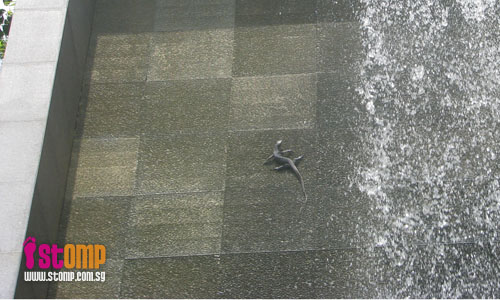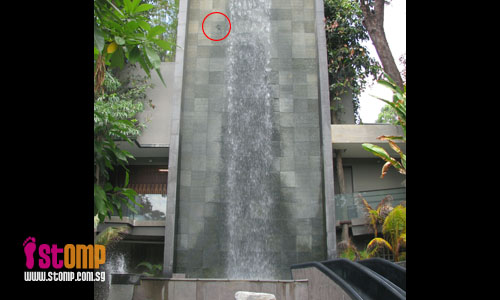
Eagle-eyed STOMPer Leon spotted this lizard scaling the vertical rock wall of Siloso Beach Resort's waterfall.
Here's what he had to say of his unusual find:
"I spotted this cute lizard climbing up and down Siloso Beach Resort's waterfall on Thursday (Jan 29).
"The waterfall is very high, approximately four stories, and the wall is practically vertical.
"I was amazed at the height the lizard had climbed to.
"At first I thought it was stuck, but I was even more amazed when it turned around and climbed down vertically, head first.
"Despite looking small in the pictures, the lizard was about four feet long, including tail."


Lizard crawls out from Chinese Garden pond. So huge, it looks like crocodile! (8th January 2009)
Related post: Poor giant lizard trapped by callous hunters (13th January 2009)
The Malayan water monitor (Varanus salvator) is quite commonly found on Sentosa; I've seen their tracks on Siloso Beach, and I have spotted them on several occasions at Tanjung Rimau and on the grounds of the Rasa Sentosa Resort. There are also signs along many of the roads, warning drivers to look out for lizards crossing the road.
This is a highly versatile creature, and is adept at swimming and climbing, as can be seen in this example.
Monitor lizards of most species will climb trees in search of prey, and as a defence mechanism. In fact, when young Komodo dragons (Varanus komodoensis) hatch, they head straight for the trees, in order to avoid predators, especially adult Komodo dragons, which will not hesitate to cannibalise smaller individuals. Only when they have spent a few years hiding in the trees do they venture to the ground, and even then, the juveniles are still not safe from predation by larger dragons.
However, according to this book on the Nile monitor (Varanus niloticus), climbing trees does have its risks. It says that:
"Unfortunately, many Nile monitors that fall asleep in the trees they climbed have lost their grip and plummeted to their death. It is not uncommon to find a dead Nile monitor lying at the base of a tall tree; Nile monitors are simply not as adept at tree climbing as some of their forest canopy-dwelling cousins."I don't know if Malayan water monitors are better climbers than their African counterparts, but I would guess that the largest individuals are definitely more or less forced to abandon any arboreal tendencies.